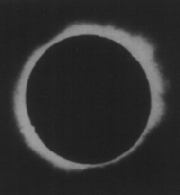Who captured the first image of a solar eclipse?
 July 28, 1851 — A total solar eclipse is first captured today in a daguerreotype photograph by Busch and Berkowski, at the Royal Observatory in Königsberg, Prussia. It showed a slight but distinct impression of the corona during the total eclipse.
July 28, 1851 — A total solar eclipse is first captured today in a daguerreotype photograph by Busch and Berkowski, at the Royal Observatory in Königsberg, Prussia. It showed a slight but distinct impression of the corona during the total eclipse.
An eclipse occurs when the moon passes between earth and sun, totally or partly obscuring the image of the Sun for a viewer on Earth. A total solar eclipse occurs when the Moon’s apparent diameter is larger than the Sun’s, blocking all direct sunlight, turning day into darkness. Totality occurs in a narrow path across Earth’s surface, with the partial solar eclipse visible over a surrounding region thousands of kilometres wide.
Berkowski, a local daguerrotypist whose first name is never published, observed the eclipse at the Royal Observatory using a small 6cm refracting telescope attached to a 15.8cm Fraunhofer heliometer camera. The daguerreotype uses an 84 second exposure shortly after the beginning of totality.
Also today: July 28, 1858 — Fingerprints are used for the first time as a means of identification.
Sources
Words of Wisdom
Nations, like stars, are entitled to eclipse. All is well, provided the light returns and the eclipse does not become endless night. Dawn and resurrection are synonymous. The reappearance of the light is the same as the survival of the soul.





